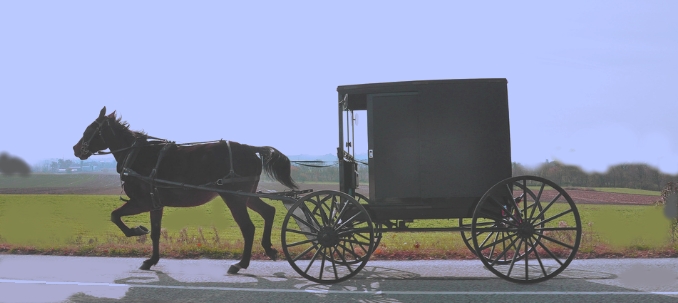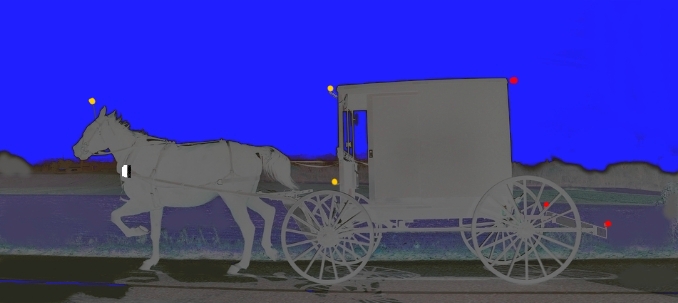 Most traffic accidents involving Amish buggies result in total destruction of the buggy
and often cause severe injury or death for anyone aboard.
Most traffic accidents involving Amish buggies result in total destruction of the buggy
and often cause severe injury or death for anyone aboard. Most traffic accidents involving Amish buggies result in total destruction of the buggy
and often cause severe injury or death for anyone aboard.
Most traffic accidents involving Amish buggies result in total destruction of the buggy
and often cause severe injury or death for anyone aboard.- Most Amish buggies are black, necessitated by the Ordnung (Amish law).
- They move slowly, usually on the shoulder if available.
- A motorist could mistake it for a motorized vehicle under poor lighting.
- The night lights are not at the outside edges of the buggy.
- Usually a buggy cannot go faster than 10 to 15 mph.
- A buggy will go much slower than 10 to 15 mph when going uphill.
- When the buggy comes to a hill going up, the horse has to slow down to pull the grade. Speed can drop to human walking speed or slower.
- The buggy has to dodge potholes and other road irregularities to avoid wheel damage.
- The horse might go to one side or the other to avoid stepping in a dangerous place
- The buggy might be pulled ahead at speed, even if it is damaged.
- The horse might rare up.
- The buggy might suddenly change direction.
- The horse might move in a way that overturns the buggy.
- This can spook the horse, causing unpredictable results (see above).
- A spooked horse might run directly in front of the car.
- The buggy could turn over in front of the car.
- NOTE: The buggy driver will pull out of the way as soon as he can, to reduce the hazard and let you pass.
- If the buggy has to stop or slow down, this can cause an accident.
- If a buggy or a tractor is beyond the crest of a hill or around the corner, a collision is quite likely.
- Often the motorist sees the buggy body, but does not see the outboard wheels or the horse. This is especially true at night.
Remember that ridden animals and animal-drawn vehicles also have the right to use the road.
- Most Amish buggies are black.
- Often the horse is a dark color too.
- The buggies are slow moving, usually on a shoulder.
- A motorist seeing only the required lights and the Slow-Moving Vehicle sign could mistake it for a motorized vehicle.
- The lights are usually on the right and left edges of the buggy body.
- The wheels project out to the sides about a foot on each side.
- The wheels project out behind the body by almost the radius of a wheel.
- The horse is in front of the front lights. Often the horse is a dark color.
- A motorist thinking the buggy is a slow car can follow too close and hit the back wheels.
- A motorist thinking the buggy is a slow car can turn or pass in front of the buggy and hit the unseen horse.
- Fog, glare, and darkness can make it hard to determine that the vehicle is a horse-drawn buggy.
- A collision from behind can damage or destroy one or both back wheels.
- A sideswipe collision can damage or destroy one or both wheels on one side.
- A right-angle collision can break all four wheels.
- The broken wheel can't hold up the buggy, so it falls toward the broken wheel.
- This may go the other way if the colliding vehicle goes under and holds up part of the buggy.
- The buggy can collapse in any direction.
- The buggy body is often destroyed when the buggy collapses.
- The occupants of the buggy will probably be killed or injured in such a collision.
- Often this throws the buggy body off the road.
- In one case, the buggy body and occupant were thrown over a guardrail and down an embankment.
- The occupants may not be in a condition able to stop or soothe the horse.
- Possibly nobody else present would have the knowledge of how to stop or soothe the horse.
- The occupants will usually be killed or injured if the buggy body is damaged or thrown.
- The surviving parts of the buggy are usually the front axle, shafts, harness parts, and the horse.
- The front axle often separates from the rest of the buggy at the steering pivot.
One would hope that the bishops of the various parishes would not oppose these safety improvements.
- Most Amish buggies are black.
- Often the horse is a dark color too.
- The lights are usually on the right and left edges of the front and back of the buggy body.
- The wheels project out to the sides about a foot on each side.
- The wheels project out behind the body by almost the radius of a wheel.
- The horse is in front of the front lights. Often the horse is a dark color.
- A motorist seeing only the required lights and the Slow Moving Vehicle sign could mistake it for a motorized vehicle.
- A motorist thinking the buggy is a slow car can follow too close and hit the back wheels because the lights are farther forward.
- Make the body of the buggy (or at least the frame) long enough that the lights are farther back than the back wheels.
- Put a bumper that is wider than the wheels on the back of the longer buggy frame.
- Put the back lights and the SMV symbol on top of the bumper.
- If the above is too heavy for the horse, put the lights on metal bars bolted to the buggy body that place the lights where they need to be (as above).
- Put the front body lights on a similar wide bar at the front of the buggy body.
- Put a light on the horse's harness on top of the head.
- Put headlights on the sides of the horsecollar two inches from the horse's body.
- The lights must be visible from the side of the buggy.
- Add reflectors to further make the buggy and horse visible.
- Reflectors at the extreme top edges of the buggy roof would make the buggy more visible over the crest of a hill.
- The lights could be individually powered or part of a wiring harness.
- It is hoped that the bishops understand that these are necessary for safety, and are not intended to decorate the buggy.
- Something stronger than wood is needed for the frame.
- The buggy must remain light enough so the horse can pull it up a hill.
- Aluminum might be a suitable material.
- A roll bar is advisable.
- Make the body of the buggy (or at least the frame) long enough that the back end is farther back than the back wheels.
- Put a bumper that is wider than the wheels on the back of the longer buggy frame.
- Use seat belts secured to the frame.
